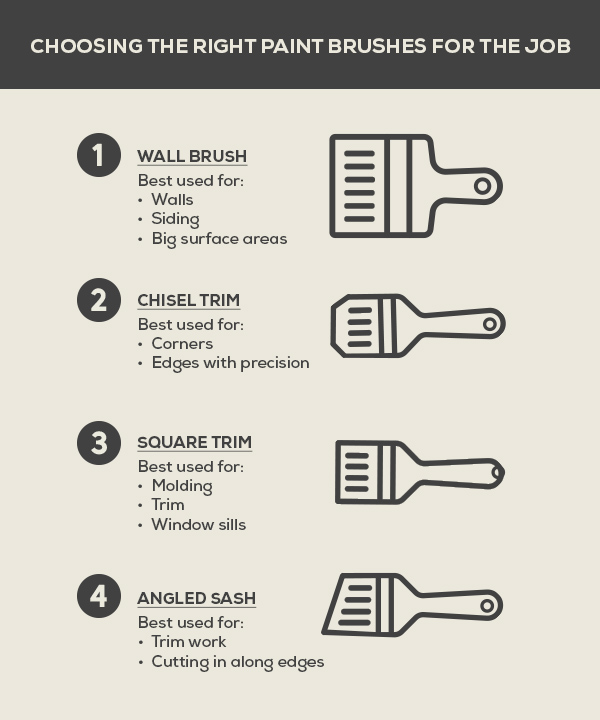

Choosing the Right Paint Brushes for the Job
Choosing the right paintbrush might seem like a small detail, but it can make or break a beautiful finish for professional painters. The right brush helps you work faster, use less paint, and leaves a smooth finish that impresses your customers. For small painting businesses—or anyone just getting started—choosing the right tools from the beginning can save you headaches and set you up for success. We'll break down everything you need to know about paintbrushes, including sizes, bristle types, brush shapes, handle styles, and practical tips for using them effectively, so you can confidently tackle any job.
Why the Right Brush Matters
The right brush in your hand matters as much as the type of paint in your can. Using the right brush based on the type of material you are painting and the type of paint you are using will help you avoid brush marks, wasted paint, or even slow down work. This means clean lines, smooth coverage, and fewer touch-ups or callbacks. For small painting businesses, efficiency and results are everything. Let's break it down.
Brush Sizes for Different Jobs
Paintbrushes usually range from one inch to four inches wide, and the right size can make a big difference in how cleanly and quickly you finish a job:
- Small brushes (1–2 inches):
- Best for detail work and tight spaces
- Ideal for window mullions, corners, trim, and crafts
- Medium brushes (2–3 inches):
- Great balance of control and coverage
- Works well for window frames, casings, baseboards, cabinets, and furniture
- Large brushes (3–4 inches):
- Designed for speed and covering bigger areas
- Perfect for siding, decks, doors, walls, ceilings, and fences
![]()
![]()
![]() Pro tip: Keep a variety of brush sizes in your kit. Having options lets you switch tools as needed and keeps your work efficient and professional.
Pro tip: Keep a variety of brush sizes in your kit. Having options lets you switch tools as needed and keeps your work efficient and professional.
Bristle Types
Not all bristles are created equally. Choosing the right type makes a huge difference in how paint goes on and how long your brush lasts. Here's a breakdown:
- Synthetic Bristles (nylon, polyester, or blends):
- Best for latex and acrylic (water-based) paints
- Hold their shape well and resist moisture, leading to a longer lifespan
- Durable, long-lasting option for everyday use
- Natural Bristles (often animal hair):
- Best for oil-based paints, varnishes, and polyurethane
- Split ends (called flagging) help hold more paint and give a smooth finish
- Not ideal for rough surfaces—tips can fray quickly
- Bristle stiffness:
- Stiff Bristles: Create crisp lines, hold heavier paints, and work well on textured or exterior surfaces.
- Soft Bristles: Reduce brush marks and give smooth finishes on cabinets, trim, and doors.


Brush Shapes and End Types
The shape of your brush plays a big role in how paint is applied and how much control you have over the finish.
- Chisel Trim:
- Slanted bristle ends for sharp, clean lines
- Great for painting corners and edges with precision
- Square Trim:
- Flat, straight bristles for covering broad, flat surfaces
- Works well for large, smooth areas where speed is important
- Angled Sash:
- Bristles cut on an angle to improve accuracy
- Perfect for trim work, cutting in along edges, and painting in tight spots
- Wall Brushes:
- Large, flat brushes designed to hold more paint
- Ideal for walls, siding, and other big surface areas
Beyond Brushes: Other Painting Tools
Brushes are great for detail work, but rollers, pad applicators, and edgers can help you work faster, cover more surface, and achieve a smoother finish on the right projects.
Rollers:
- Why use them: Rollers cover large areas quickly, lay down even coats, and reduce visible brush marks. They're especially useful for walls, ceilings, and other broad surfaces.
- When to use them: They are ideal for big jobs like interior walls, exterior siding, floors, and masonry, where speed and consistency are key.
- Sheen:
- Knit: Flat, eggshell, satin. Excellent pickup and release for the fastest coverage.
- Woven: Enamels, primers, all types of paints including gloss. "Double Lock" process results in the smoothest, almost lint-free finish.
- Note: The higher the sheen, the more the surface will show lint from the roller.
Pile depth (nap thickness)
- Very smooth (1/4"): Metal, plaster, or ultra-smooth surfaces.
- Smooth to semi-smooth (3/8"–1/2"): Drywall and lightly textured walls.
- Semi-rough (3/4"): Rough wood or lightly textured surfaces.
- Rough (1" or more): Stucco, brick, concrete block, heavily textured surfaces.
Paid Applicators:
- Flat pad covered in fabric that holds and releases paint evenly.
- Create smooth, streak-free finishes with little splatter.
- Excellent for exterior siding, concrete block, floors, and large interior walls.
Paint Edgers:
- Small pads with guide wheels or built-in edges.
- Allow you to paint right up against trim, ceilings, or baseboards without bleeding over.
- Save time on cutting-in and reduce or eliminate the need for masking tape.
Choosing the right brush comes down to knowing the size, bristle type, shape, and handle best fit your project. The right tools make your work easier and deliver smooth, professional results that customers expect. For small painting businesses, investing in quality brushes is an investment in customer satisfaction and repeat business. At McCoy's, you'll find everything you need to build a reliable painting toolkit—from quality brushes and rollers to pad applicators and edgers. Take advantage of our loyalty program and earn discounts toward every paint purchase.

Reviewed by Gloria Gonzales
McCoy's In-House Expert
